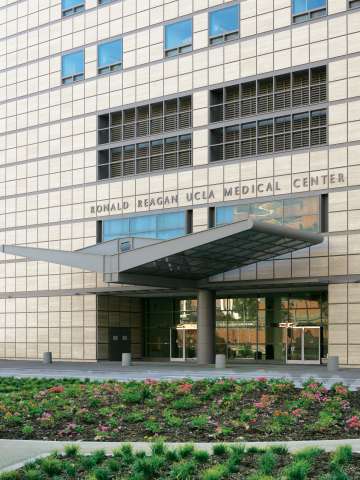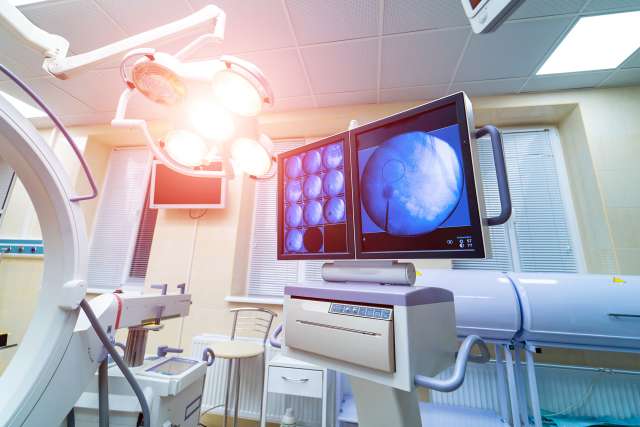Interventional Radiology
Our interventional radiologists perform minimally invasive procedures to treat blood vessels without the need for open surgery. These procedures offer exceptional results with shorter recovery times.

What is interventional radiology?
Interventional radiology is a medical specialty that uses minimally invasive techniques to treat many conditions that once required open surgery with a large incision. Interventional radiologists use small, hollow tubes (catheters), miniature instruments and imaging guidance to directly access arteries and veins without making large incisions.
UCLA Health excellence in interventional radiology
UCLA Health interventional radiologists are experts in treating a wide range of conditions that affect blood vessels.
Highlights of our program include:
Improved outcomes: We offer effective treatment with reduced risks and decreased recovery times while avoiding the need for open surgery. Our specialists have the expertise to treat complicated conditions safely and effectively, allowing patients to get back to their normal lives more quickly.
Established experts: Our interventional radiologists are board-certified physicians with advanced training in diagnostic radiology, plus additional training in vascular and interventional procedures. This comprehensive background allows us to quickly and accurately visualize, diagnose and treat many vascular conditions.
Research emphasis: A strong focus on research allows us to rapidly implement new, sometimes revolutionary, imaging and therapeutic techniques. Eligible patients may have access to new treatments through clinical trials.
Multispecialty care: We collaborate with multiple specialists throughout UCLA Health to offer these advanced interventional procedures. Our team approach includes doctors in cardiac surgery, radiology, cardiology, anesthesia, urology, gastroenterology, head and neck surgery and more.
Our areas of care
Interventional radiologists can treat conditions occurring throughout the body. We offer specialized services for a range of conditions.
Fibroid care
A coordinated team of interventional radiologists, gynecologists, urogynecologists and nurse practitioners work together to diagnose and treat uterine fibroids. Uterine fibroids are small, typically noncancerous, growths in the uterus. We evaluate each patient’s needs to create personalized, effective care plans.
Interventional radiologists may perform an embolization procedure, in which they guide a catheter to the blood vessels that are supplying the fibroids with blood. They send small particles through the catheter that block the blood vessels. This restricts blood flow to the fibroids and causes them to shrink. Up to 90% of women experience significant relief from heavy bleeding after embolization.
Inferior Vena Cava (IVC) Filter Clinic
The specialists in the IVC Filter Clinic specialize in placing and removing IVC filters. An IVC filter is a small device placed in the inferior vena cava, the large vein running through the middle of the body. The filter traps blood clots to prevent them from traveling to the heart or lungs.
These filters can be lifesaving treatments for many people. However, they aren’t always meant to stay in place long-term. Our interventional radiologists are experts in determining when the filters are needed, and then placing them or removing them.
Spine Center
Interventional radiologists work with neurosurgeons, orthopedic surgeons, physical medicine and rehabilitation physicians and nurse practitioners to care for patients with spinal disorders, deformities or injuries. We actively research new techniques and continually bring patients the most effective treatment options.
Our interventional radiologists may treat patients with spinal fractures that compress the spine and decrease height. We use techniques such as vertebroplasty and kyphoplasty to stabilize the spine and restore height.
Thyroid fine needle aspiration (FNA) biopsies
Our radiologists work with specialists in the Endocrine Center to offer thyroid FNA biopsies. During this minimally invasive procedure, we collect a few cells from the thyroid, a butterfly-shaped gland that produces hormones. Our specialists analyze this cell sample under a microscope to diagnose or rule out conditions that affect your thyroid.
We perform over 1,000 thyroid biopsies each year. At many of our clinics, we offer same-day thyroid FNA biopsies, so you have easy access to the care you need.
Varicose Vein Clinic
Interventional radiologists in the Varicose Vein Clinic specialize in treating venous insufficiency, a condition in which blood doesn’t flow from your legs back to your heart as it should. We use minimally invasive techniques to treat venous insufficiency and varicose veins. These approaches offer better cosmetic results with smaller entry points.
The multispecialty team includes physicians, nurse practitioners, nurses and technologists dedicated to venous insufficiency treatment. We are active researchers, continually learning and implementing the most effective new treatments.
Conditions interventional radiologists treat
Interventional radiologists treat a spectrum of conditions affecting virtually any part of the body. We may treat:
Arterial conditions
We treat a variety of conditions that affect the arteries, including:
- Aneurysms: Weakening in a blood vessel wall that can result in a bulge
- Arteriovenous malformations (AVM): Irregular connections between arteries and veins
- Dissections: Tears in the inside layer of a blood vessel wall
- Hereditary hemorrhagic telangiectasia (HHT): A rare disorder in which abnormal connections form between arteries and veins
- Peripheral arterial disease (PAD): A blockage in blood vessels that significantly reduces blood flow to the limbs
Gastrointestinal conditions
Our specialists may offer treatment for conditions affecting the digestive tract, such as:
- Gastrointestinal bleeding: Bleeding in any part of the digestive tract, which includes the esophagus, stomach, small and large intestines, rectum and anus
- Gastrointestinal ischemia: Decreased or blocked blood supply to the digestive tract
- Malnutrition: A condition in which a person doesn’t get the nutrients needed for growth and function
- Obstruction: A partial or complete blockage anywhere along the gastrointestinal tract
Liver and biliary conditions
We also treat disorders that affect the liver, the large organ that helps filter blood, and bile, the digestive fluid the liver produces. These conditions may include:
- Ascites: Fluid buildup in the peritoneal cavity, the empty space around the abdominal organs
- Biliary leak: A leak in any of the ducts that carry bile to the small intestine
- Biliary obstruction: A blockage in any of the ducts that transport bile to the small intestine
- Hepatic encephalopathy: A condition in which liver damage affects brain function
- Liver cancer: Cancer of the liver, starting in the liver, such as hepatocellular carcinoma, or starting elsewhere and spreading to the liver (metastatic liver cancer)
- Portal hypertension: Increased pressure in the portal venous system, the network of veins that drains blood from the abdominal organs to the liver
- Variceal bleeding: Irregularly enlarged (dilated) veins in the digestive tract that may rupture and bleed
Male and female reproductive conditions
Interventional radiologists may also treat male and female reproductive conditions, such as:
- Benign prostatic hyperplasia: Age-related prostate enlargement
- Pelvic congestion syndrome: Irregular enlargement of the pelvic veins, including around the ovaries
- Uterine fibroids: Tumors that grow in the uterus and are almost always noncancerous (benign)
- Varicocele: Irregular enlargement of the veins in the scrotum
Orthopedic conditions
We collaborate with orthopedic specialists to treat:
- Osteoarthritis of the knee: Breakdown of knee cartilage, the protective padding between bones of the upper and lower leg
- Vertebral fracture: A break in any of the bones that make up the spine (vertebrae)
Venous conditions
Interventional radiologists also treat conditions that affect the veins, including:
- Deep vein thrombosis (DVT): Blood clots within veins, usually in the legs
- Pulmonary embolism: Blood clots in the lungs, often traveling there from the legs
- Varicose veins: Enlarged, twisted veins, most commonly occurring in the legs
- Venous and lymphatic malformations: Atypically enlarged veins or lymphatic vessels that are present at birth
Interventional radiology procedures we offer
Interventional radiologists use small, hollow tubes (catheters) and imaging tools to access blood vessels without the need for open surgery. We offer a number of minimally invasive treatments, including:
Angiography: We insert a catheter through an artery at the groin. Then, we inject contrast dye through the catheter and use X-rays, CT scans or MRIs to view arteries.
Angioplasty: We access a blocked artery with small catheters and special wires. Then, we place a small balloon device to inflate and open the artery. This is a common procedure for PAD and may also be used in some cases of gastrointestinal ischemia.
Balloon-occluded retrograde transvenous obliteration (BRTO): This procedure may treat hepatic encephalopathy, portal hypertension or gastric variceal bleeding. We insert a catheter with a small balloon through a vein in the groin. Then, we guide it to the liver and find the enlarged (dilated) veins. We then expand the balloon, blocking blood flow to these veins to reduce bleeding risk.
Biopsy: We use CT or ultrasound guidance to place a needle into diseased tissue and obtain a small sample. Biopsies check tissue for cancer or other diseases.
Drainage: We use ultrasound or CT guidance to place a small drainage tube in areas where there is atypical fluid collection. We may use this treatment for infections (abscess), ascites, biliary leak or obstruction, or other fluid buildup.
Embolization procedure: Embolization blocks blood flow to certain areas. We use catheters and small instruments to inject special chemicals or place small coils into specific arteries. This procedure can be used for many conditions, including aneurysms, BPH, dissections, gastrointestinal bleeding, HHT, liver cancer, knee osteoarthritis, pelvic congestion syndrome, pulmonary AVMs, uterine fibroids, varicoceles and venous and lymphatic malformations.
Gastrostomy and gastrojejunostomy tube placement: We may place a feeding tube into the stomach (gastrostomy tube), or we may place a tube that passes from the stomach to the small intestine (gastrojejunostomy tube). Both of these feeding tubes are treatments that provide nutritional support.
Inferior vena cava (IVC) filter placement and removal: An IVC filter is a small device placed in the large vein that runs through the middle of the body. The filter traps blood clots to prevent them from moving to the heart or lungs. We may place or remove these filters, depending on the patient’s needs. This procedure may be used for DVT or pulmonary embolism.
Stent placement: Stents are treatments for blocked arteries. We use small wires and catheters to place a flexible metal or mesh tube (stent) in a blocked artery. The stent keeps the artery open so blood can flow properly. The procedure may be performed during angioplasty for PAD or gastrointestinal ischemia.
Thrombolysis: This is a treatment to dissolve blood clots. We may inject clot-busting medicines through a catheter, or we may insert a small device that traps and removes the clot or breaks it up. This procedure may be used for DVT, pulmonary embolism and some cases of gastrointestinal ischemia.
Transjugular intrahepatic portosystemic shunt (TIPS): TIPS is a treatment for ascites or portal hypertension. The interventional radiologist guides a catheter into the vein that drains the liver (hepatic vein). Then they place a stent between the portal vein and hepatic vein to relieve pressure. It may also be used to stop variceal bleeding.
Tumor ablation: The interventional radiologist uses ultrasound or CT guidance to insert a specialized needle into a tumor. Then they use heat, cold or electric energy to destroy the tumor without the need for open surgery.
Vascular access: The interventional radiologist inserts a catheter into a blood vessel to allow easier access for blood draws or infusions. These catheters allow patients to receive intravenous (IV) treatments without the need for repeat skin punctures. It may be appropriate for patients who are on chemotherapy or hemodialysis (a kidney treatment that cleanses blood of excess waste) or who need repeat blood draws.
Vertebroplasty and kyphoplasty: Vertebral compression fractures occur in the spinal bones called vertebrae. The fracture decreases the height of a vertebra by at least 15%. We can treat these fractures by stabilizing the fracture with a special cement (vertebroplasty) or restoring height by inflating a balloon inside the spine (kyphoplasty) and then injecting the cement.
Our expert interventional radiology team
Our interventional radiologists are board-certified physicians with advanced, specialty training in interventional procedures. We provide a range of treatments to care for patients with blood vessel conditions without the need for open surgery. Our experts collaborate with multiple teams across UCLA Health to offer comprehensive, multispecialty care.
Contact us
Call 310-481-7545 to request an appointment with an interventional radiologist at UCLA Health.
Find your care
Our board-certified physicians diagnose and treat many vascular conditions. Call 310-481-7545 to learn more about interventional radiology services.

















